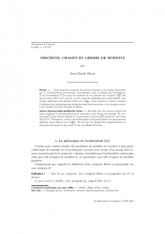Descente, champs et gerbes de Hurwitz
Descent, Stacks and Hurwitz Gerbs
Séminaires et Congrès | 2001

- Consulter un extrait
- Année : 2001
- Tome : 5
- Format : Papier
- Langue de l'ouvrage :
Français - Class. Math. : 18G50, 14E20, 14Dxx, 14D22
- Pages : 119-131
Nous montrons comment les notions de gerbe et de champ introduites par A. Grothendieck interviennent naturellement dans la théorie des revêtements. À un $G$-revêtement $\overline f$ de corps des modules $K$ est associée une $K$-gerbe $\mathcal {G}(\overline f)$ liée par le centre $Z(G)$ de $G$ qui est, en fait, la gerbe résiduelle en le point $\mathrm {Spec} K$ d'un champ algébrique plus général défini sur $Z[\frac {1}{|G|}]$. Nous montrons ensuite comment l'utilisation des approximations diophantiennes dans les gerbes et les champs conduit à des résultats du type Principe de Hasse.
Champs, gerbes, revêtement, descente, modules grossiers, modules fins
